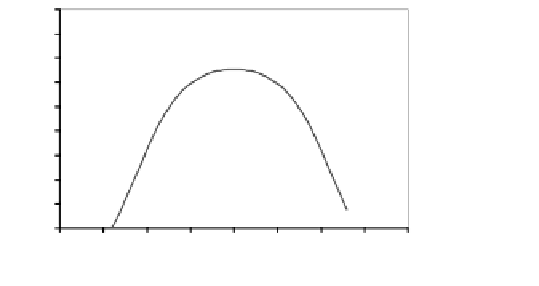Environmental Engineering Reference
In-Depth Information
the local conditions - via the large and small-scale interdependencies within the
atmosphere.
In order to be able to evaluate a concrete site, e.g. for the installation of a solar
panel, the shading of direct solar radiation by mountains, buildings and trees has
to be considered. So-called solar-position plots (Fig. 2.20) can be used to measure
the shading. For every 21
st
day of each month, for a particular latitude, the solar
position (i.e. the angle between the solar radiation incident and the horizontal)
above the solar azimuth (i.e. the deviations of the solar position from the Southern
direction) is shown on these diagrams. Additionally, the corresponding time for
the respective solar position is included.
90
21. Jun
21. May/Jul
21. Apr/Aug
21. Mar/Sep
21. Feb/Oct
21. Jan/Nov
21. Dec
Horizon
80
70
12h
21.Jun
60
10h
14h
50
21.Mar/Sep
8h
16h
40
Horizon
30
6h
18h
20
21.Dec
10
0
-180 -135 -90 -45
0
45
90
135
180
North
East
South
West
North
Fig. 2.20
Solar-position plot with an included horizon for sites at 48° Northern latitude
(see /2-14/)
Az imuth in °
The outlines of surrounding elevations can now be entered into such a solar-
position plot. Afterwards, the relevant daily and seasonal shading effects can be
read from the diagram. Such a graphic can, for example, help identify the ideal
positioning of a house which is supposed to generate high passive solar yields for
an optimum use of solar radiation, keeping shading as low as possible during the
times when solar energy should be used.
The alignment of a solar panel is also decisive for its energy output. Fig. 2.21
therefore shows the monthly overall global radiation (i.e. the total of direct and
diffuse radiation) on surfaces with different alignments for a location in Central
Europe. According to that, during the heating period in the winter months, the
highest radiation amount of all vertical surfaces, incidents on the vertical surface
aligned towards the South. Outside the heating period in the summer months, the
radiation amount on the southern vertical surface is lower than on vertical surfaces
aligned towards East or West. During the heating period, only diffuse radiation
incidents on vertical surfaces aligned to the North. Skylights inclined 45° to the
South have a very high radiation incident during the summer. During the winter,
however, radiation is similar to the vertical Southern wall. Therefore sunspaces
with glazing slanting towards the South, for example, often show the problem of
overheating during the summer. The top curve shows the theoretical maximum of































































Search WWH ::

Custom Search